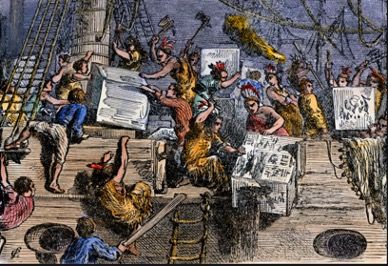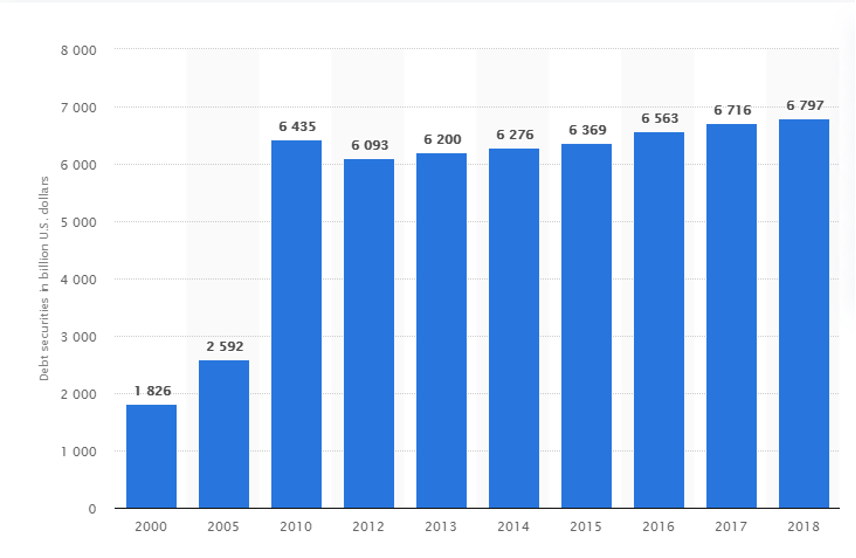247 years ago, on December 16, 1773, one of the most infamous
American political events took place: the Boston Tea Party. On that night so
many winters ago, a large group of colonists led by Sam Adams and John Hancock,
having had enough of the taxes imposed by the British, decided to take the tea
from the holds of three ships recently arrived from China and throw it all into
the Boston harbor. The Dartmouth, the Beaver and the Eleanor were all loaded to
the gills with tea. A group of around one-hundred Sons of Liberty dressed themselves
in native garb and boarded the ships. When imagining dumping tea chests into
the harbor, I normally picture some "normal" sized chests, maybe the size of
footlockers, going overboard to bob the night away in the cold water. In fact,
however, according to History
magazine, the total volume of tea dumped over the course of three hours that
night was 45 tons! I'm guessing the chests were larger than I had been
picturing.
Experts on the topic say that the tea that was destroyed
that night would have a market value of over 1 million dollars today. It would not, however, have been enough tea to
turn the harbor into a satisfying brew, even if the water had been much warmer.
You can read a fun, related analysis here.

As is usual with these historical founding tales, there is a
less-well-known backstory. It turns out that some of the leaders of the Sons of
Liberty—namely the aforementioned Adams and Hancock—also presided over very
profitable tea smuggling operations. So yes, while they were indeed fighting
against taxation without representation, they also had a financial interest in
the price of tea. Which motivation dominated? I will leave to your meditation.
If any readers from the Boston area can give us some more local details, we may
learn more.
This event had major repercussions. King George and Parliament
were "not amused." The harbor was closed until the ruined tea was paid for, and
other responses, known as the Coercive Acts, were imposed, including martial
law. Many historians say that in this way, the tea party lit the flame of the
movement towards complete independence from Britain. At the time, however, many
notable colonials decried the destruction of private property (including George
Washington).
So, we are at the anniversary of this important American historical event, but how am I ever going to tie that into investing?
This headline from Bloomberg got me to thinking about the
taxation without representation that goes on every day via the Government Sponsored
Entities, or GSEs:
"GSE trading increased to $3.8b
yesterday from $3b the previous session, according to TRACE. The previous
Tuesday saw $4b, and the average volume over the last 10 Tuesdays when the
market was open is $4.7b."
The vast majority of this volume of GSE bonds being traded can
be described as callable agency debentures, and right now, they should be thrown
into the harbor, just like the tea.
What? I'll get to that, but first, let us take a step back.
Why do GSEs even exist? The first one, the Federal Loan Bank, was created in
1916 to assist banks in creating farm credit. A noble purpose, no doubt. Later
came Fannie Mae and Freddie Mac, who helped provide liquidity to the housing debt
market, and later still Sallie Mae, who likewise provided liquidity for student
loans. Another critical cooperative GSE known as the Federal Home Loan Bank
system was created to assist banks with lending facilities and to help
coordinate the operational portion of Fannie and Freddie's mission. The FHLBs
are actually owned by their members, and no one can deny that they are now a
critical component of the banking system in the United States. As near as I can
divine, all of these GSEs were intended to be "for profit" entities, and the innovation
of pooling assets and reselling them into the market place with a quasi-governmental
guarantee has revolutionized banking and investing in the United States (and
arguably in all advanced economies).
So, if they have revolutionized banking across the globe,
why would I want to throw their securities into the harbor? Seems a bit of a
leap. And I should add that it's not all
of their securities that need to go overboard—it's their direct debt (their debentures)
and specifically those debentures with imbedded options.
As you can see in the Statista graph below, the amount of
debt issued by the GSEs has nearly quadrupled over the last decade. Sadly, much
of this has included imbedded call options.

Banks and credit unions across the United States are very
active participants in this space and, as we have discussed before, they are
therefore in aggregate short massive amounts of call options.
Take a moment to consider why this has happened. Who
benefits?
First, we must remember that the bonds being issued by the
GSEs are their liabilities.
Second, we must remember that the GSEs are for-profit entities.
They do not make specific transactions (like issuing callable bonds over more
bullet bonds) unless they believe them to be profitable for them.
Third, the GSEs must "pay" the broker-dealers who distribute
their debentures, by delivering the securities at a discount to the
underwriters, much like a bank issues CDs through brokers at a face discount.
Fourth, as the FINRA website accurately describes these
bonds' call risk:
"Many agency securities—step-ups in
particular—carry call provisions that allow the issuer to pay you prior to the
bond's maturity date, typically when interest rates drop, leaving you to
reinvest at lower prevailing rates."
When we combine the facts above, we can see why and how the purchasers
of this debt are intentionally left holding the bag. Not only have they
provided the agencies with a repriceable liability portfolio which has been
resetting down to lower and lower rates over the past 10-15 years (and will not
symmetrically rise if rates climb until their issues mature), these investors
have provided this at an unfairly low price. The brokers selling these
securities have recycled the trade, over and over again. Many brokers would rather
place a callable bond in a client's portfolio simply because it comes with a
good likelihood of creating a new transaction opportunity prior to maturity.
Why do I say unfairly low price? Today, this has reached
unbelievable levels.
7-year maturities with a 1-year
call at a yield of 0.80%...on the same day a non-callable 7 year was issued at
the same rate!
5-year maturities with a 1-year call at a yield of 0.52%
I could go on and on. These bonds are trading at almost the
exact same yields as the underlying, non-callable bullet agencies of the same
maturities. Many of them trade a spread of less than 5 bps. In short, these
options are being "sold" by investors who buy the bonds for almost nothing—in
some cases, for exactly nothing.
The two other parties to this deal—the agencies and the
brokers—get virtually free option value for the future, to reprice their
liabilities (agencies) or the chance to sell early replacements (brokers).
Sometimes, I feel like I'm ranting like a lunatic, but I'm
always hopeful that some new Sons of Liberty will rise up and smash today's allegorical
tea chests.
Speaking of rants, who can forget the famous Jim Cramer rant of
2008? Shortcut to the 1:40 mark!
Please understand this: I am not categorically opposed to
owning bonds with imbedded short option positions, that is, bonds that can be
called or prepaid. But I only want to consider that when the reward for the
short option risk is attractive enough.
Today, it is nowhere near enough. I just can't get that voice out of my head
screaming at me: Don't sell cheap options!
Final, final thought: We have all seen the footage of the
nurses and other front line health workers getting vaccinated. I'm so thankful
for their sacrifice, risk-acceptance, and hard work. They are amazing heroes.
For the first time in ten months, it feels like there is a light at the end of
the tunnel.


